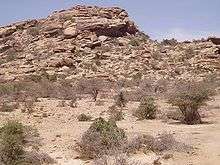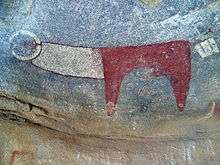Laas Geel
| Laas Geel | |
|---|---|
|
| |
| Location |
Laas Gaal, |
| Access | Public |
Laas Geel (Somali: Laas Geel), also spelled Laas Gaal, are cave formations on the rural outskirts of Hargeisa, Somalia. They contain some of the earliest known cave paintings in the Horn of Africa. Laas Geel's rock art is estimated to date to somewhere between 9,000–3,000 BC.
Discovery

During November and December 2002, an archaeological survey was carried out in Somalia by a French team of researchers. The expedition's objective was to search for rock shelters and caves containing stratified archaeological infills capable of documenting the period when production economy appeared in this part of the Horn of Africa (circa 5,000 and 2,000 BC). During the course of the survey, the French archaeological team discovered the Laas Geel cave paintings, encompassing an area of ten rock alcoves (caves).[1] In an excellent state of preservation, the rock art depicts both wild animals and decorated cows. They also feature herders, who are believed to be the creators of the paintings.[2] Laas Geel's rock art is in the same distinctive Ethiopian-Arabian style as the Dhambalin and Karinhegane cave paintings that are also found in northern Somalia.[3]
The Laas Geel rock art had been known to the area's inhabitants for centuries before the French discovery. However, the existence of the site had not been broadcast to the international community. In November 2003, a mission returned to Laas Geel and a team of experts undertook a detailed study of the paintings and their prehistoric context.
Northern Somalia in general is home to numerous such archaeological sites, with similar rock art and/or ancient edifices found at Haylan, Qa’ableh, Qombo'ul and El Ayo. However, many of these old structures have yet to be properly explored, a process which would help shed further light on local history and facilitate their preservation for posterity.[4]
Description
The Laas Geel cave paintings are thought to be some of the most vivid rock art in Africa. Among other things, they depict cows in ceremonial robes accompanied by humans, who are believed to have been inhabitants of the region. The necks of the cows are embellished with a kind of plastron. Some of the cows are also portrayed wearing decorative robes. Besides long-horned cattle, the rock art also shows an image of a domesticated dog, several paintings of canidae as well as a giraffe.[1]
Gallery
 Depiction of a ceremonial cow
Depiction of a ceremonial cow A human and cow
A human and cow A herd of cows
A herd of cows A single cow
A single cow One of the alcoves at Laas Geel
One of the alcoves at Laas Geel Various rock art
Various rock art- Various other rock art
Notes
- 1 2 The Journal of African Archeology Volume 1.2 (2003) Chapter 3
- ↑ Bakano, Otto (April 24, 2011). "Grotto galleries show early Somali life". AFP. Retrieved 11 May 2013.
- ↑ Istituto universitario orientale (Naples, Italy) (1992). Annali: Supplemento, Issues 70-73. Istituto orientale di Napoli. p. 57.
- ↑ Michael Hodd, East African Handbook, (Trade & Travel Publications: 1994), p.640.
External links
Coordinates: 9°46′51″N 44°26′37″E / 9.780911°N 44.443642°E
